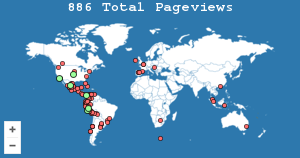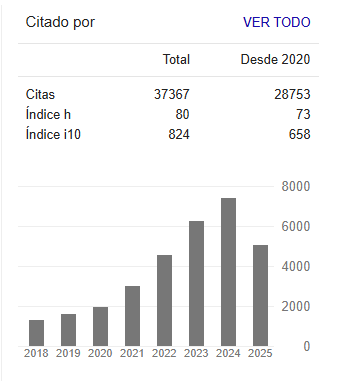Organizational change: a theoretical vision of its conceptual evolution
Abstract
The objective of this article was to show the evolution of the conceptual framework that organizational change has undergone through academic history, to contribute widely to the understanding of the situations that companies experience in terms of organizational change. The research carried out is descriptive. In turn, it is bibliographic in nature through the analysis of specific literature on the subject described. The data record sheet applied to books and scientific articles was used, which allowed the registration and identification of information sources. It was found that the definitions have two defined approaches: behavioral and organizational. It is concluded that the proposals are based on rational models of reality, which implies a bias and heuristics of the authors in the presentation of their own vision of the facts.
References
Ansoff, H. (1965). Corporate Strategy: An Analytical Apporach to Business Policy for Growth and Expansion. McGraw-Hill.
Beckhard, R., Lopera, J., & Casas, H. (1973). Desarrollo organizacional: estrategias y modelos. Mexico, D.F.
Beer, M. (1980). Organization change and development: A systems view Goodyear. Santa Monica, CA: Scott Foresman & Co.
Bennis, W.G. (1966). Desarrollo organizacional; su naturaleza, sus orígenes y perspectivas. Fondo Educativo Interamericano.
Bernal, C. (2010). Metodología de la Investigación, Para Administración, Economía y Ciencias Sociales. Pearson Educación.
Blake, R., R, Mouton, J., S, & Bidwell, A., C. (1962). Managerial grid. Advanced Management-Office Executive.
Boyatzis, R. (1982). The Competent Manager, A Model for Effective Performance. John Wiley & Sons, Inc.
Burke, W. W. (1994). Organization change: Theory and practice: Sage Publications.
Burke, W.W., & Litwin, G.H. (1992). A causal model of organizational performance and change. Journal of Management, 18(3), 523-545.
Castillo, L. (2006). La flexibilidad como capacidad asociada al recurso humano generadora de desempeño organizacional superiror. (Maestría), Universidad Nacional de Colombia, UNAL, Manizales.
Collis, D., & Montgomery, C. (1995). Competing on Resources: Strategy in the 1990s. Knowledge and Strategy, 25-40.
Cummings, T. G., & Worley, C. G. (2005). Organization development and change. South Western: Mason.
Chandler, A. D. (1962). Strategy and structure: Chapters in the history of the industrial enterprise. Washington D.C.: Beard Books.
Chandler, A. D. (1977). The Visible Hand: The managerial revolution in American business. Cambridge, MA / Londres: The Belknap Press of Harvard University Press.
Chiavenato, I. (2001). Administración: teoría, proceso y práctica. McGraw-Hill.
Chiavenato, I. (2011). Fundamentos de administración. McGraw-Hill.
De Faria, M., & Fernando, A. (1995). Desarrollo organizacional: enfoque integral. Limusa.
Española, R. A. (2000). Diccionario de la lengua española. Real Academia Española.
Etkin, J. R. (2000). Política, gobierno y gerencia de las organizaciones: acuerdos, dualidades y divergencias. Pearson Educación.
Fierro-Celis, F.A. (2020). Cambio organizacional: un modelo que dinamiza la transformación. Revista Escuela de Administración de Negocios, 88(enero-junio), 1-26.
Fleishman, E.A. (1953). Leadership climate, human relations training, and supervisory behavior. Personnel psychology, 6(2), 205-222.
Ford, J.D., & Ford, L.W. (1994). Logics of identity, contradiction, and attraction in change. Academy of management review, 19(4), 756-785.
French, W.L., & Bell, C.H. (1990). Organization Development. Englewood Cliffs, NJ: Prentice-Hall.
French, W.L., & Bell, C.H., Jr. (1995). Organization Development: Behavioral Science Interventions for Organization Improvement. Prentice Hall.
Friedman, T. (2006). La tierra es plana, breve historia del mundo globalizado del siglo XXI. Planeta Colombiana S.A.
Garten, J.E. (2001). La mentalidad del C.E.O. Editorial Norma.
Gersick, C.J. (1991). Revolutionary change theories: A multilevel exploration of the punctuated equilibrium paradigm. Academy of management review, 16(1), 10-36.
Gordon, J. (1997). Comportamiento organizacional. Prentica Hall.
Greiner, L.E. (1972). Evolution and revolution as organizations grow. Harvard Business Review, 76(3), 55-64.
Guizar, R. (1998). Desarrollo organizacional: principios y aplicaciones. McGraw-Hill.
Gupta, A., & Govindarajan, V. (1984). Business unit strategy, managerial characteristics, and business unit effectiveness at strategy implementation. Academy of Management journal, 27(1), 25-41.
Hall, E., & Hall, M. (1990). Understanding cultural differences: “Germans, French and Americans” (Vol. 9). Yarmouth, ME: Intercultural press, Inc.
Hamel, G. (2008). El Futuro de la Administración. Carvajal Education.
Hammer, M., & Champy, J. (1994). Reingeniería. Editorial Norma.
Harris, R.T., & Beckhard, R. (1987). Organizational transitions: Managing complex change. Reading, Mass.: Addison-Wesley Publishing Company.
Hernández, R., Fernandez, C., & Baptista, P. (2010). Metodología de la Investigación. México, Mc Graw Hill.
Hornstein, H.A., Callahan, D.M., Fisch, E., & Benedict, B.A. (1968). Influence and satisfaction in organizations; A replication. Sociology of Education.
Huber, G.P., Sutcliffe, K.M., Miller, C.C., & Glick, W.H. (1993). Understanding and predicting organizational change. Organizational change and redesign: Ideas and insights for improving performance, 215, 265.
Kaplan, R.S., & Norton, D.P. (2000). Cómo utilizar el cuadro de mando integral: para implantar y gestionar su estrategia. Gestión 2000.
Khadem, R., & Lorber, R. (1997). Administración en una página: cómo utilizar la información para lograr sus metas: Norma.
Kilmann, R. (1989). Managing Beyond the Quick Fix. Jossey-Bass.
Kim, W.C., Mauborgne, R., & De Hassan, A. (2005). La estrategia del océano azul: cómo crear en el mercado espacios no disputados en los que la competencia sea irrelevante. Grupo Editorial Norma.
Kolb, D. (1984). Experimental learning: Experience as the source of learning and development. Prentice Hall.
Kotler, P. (2006). Dirección de marketing. Pearson Education.
Kuhn, T.S. (1971). La estructura de las revoluciones científicas. Fondo de Cultura Económica.
Lawler III, E.E., & Suttle, J.L. (1973). Expectancy theory and job behavior. Organizational behavior and human performance, 9(3), 482-503.
Levy-Leboyer, C. (1997). Gestión de las competencias: cómo analizarlas, cómo evaluarlas, cómo desarrollarlas. Les éditions d´organisation.
Lewin, K. (1951). Field theory in social science: selected theoretical papers (edited by dorwin cartwright.).
Likert, R. (1967). The human organization: its management and values.
Lippitt, R., Watson, J., & Westley, B. (1958). La dinámica del cambio planificado.
Margerison, C. (2001). Team competencies. Team Performance Management, 7(7/8), 117-122.
Mayo, E. (1949). The social problems of an industrial civilization. Routledge.
Miller, D., & Toulouse, J.M. (1986). Chief executive personality and corporate strategy and structure in small firms. Management science, 32(11), 1389-1409.
Mintzberg, H. (1973). Nature of managerial work. Harper & Row.
Mintzberg, H., Ahlstrand, B., & Lampel, J. (1998). Strategy Safari: A Guided Tour Through The Wilds of Strategic Mangament. The Free Press.
Morgan, G. (1997). Images of organization. Sage Publications.
Nadler, D.A., & Tushman, M.L. (1980). A model for diagnosing organizational behavior. Organizational Dynamics, 9(2), 35-51.
Payne, A., & Frow, P. (2005). A strategic framework for customer relationship management. Journal of marketing, 69(4), 167-176.
Porras, J.I. (1987). Stream analysis: A powerful way to diagnose and manage organizational change. Prentice Hall.
Porras, J.I., & Robertson, P.J. (1992). Organizational development: Theory, practice, and research. Consulting Psychologists Press.
Porter, M.E. (1990). Competitive advantage of nations: creating and sustaining superior performance. Simon and Schuster.
Priem, R.L., & Butler, J.E. (2001). Is the resource-based “view” a useful perspective for strategic management research?. Academy of management review, 26(1), 22-40.
Robbins, S.P. (2004). Comportamiento organizacional. Pearson educación.
Romero, J., Matamoros, S., & Campo, C.A. (2013). Sobre el cambio organizacional. Una revisión bibliográfica. INNOVAR Revista de Ciencias Administrativas y Sociales, 23(50), 35-52.
Simon, H.A. (1957). A behavioral model of rational choice, in models of man, social and rational: mathematical essays on rational human behavior in a social setting. New York: Wiley.
Spencer, L., & Spencer, S. (1993). Competence at Work models for superior performance. John Wiley & Sons.
Sternberg, R.J. (1982). Handbook of human intelligence. CUP Archive.
Taylor, F.W. (1971). Principios de la administración científica. Herrera Hermanos.
Teece, D.J. (1980). Economies of scope and the scope of the enterprise. Journal of economic behavior & organization, 1(3), 223-247.
Teece, D.J., Pisano, G., & Shuen, A. (1997). Dynamic capabilities and strategic management. Strategic Mangement, 18(7), 509-533.
Tichy, N.M. (1983). Managing strategic change: Technical, political, and cultural dynamics (Vol. 3). New York: John Wiley & Sons.
Trist, E., & Murray, H. (1993). The social engagement of social science. volume II: The socio-technical perspective: Philadelphia: University of Pennsylvania Press.
Tversky, A., & Kahneman, D. (1974). Judgment under uncertainty. Heuristics and biases. science, 185(4157), 1124-1131.
Von Bertalanffy, L. (1969). General systems theory and psychiatry—an overview. General systems theory and psychiatry, 32(4), 33-46.
Weick, K.E., & Quinn, R.E. (1999). Organizational change and development. Annual Review of Psychology, 50(1), 361-386.








.png)






























